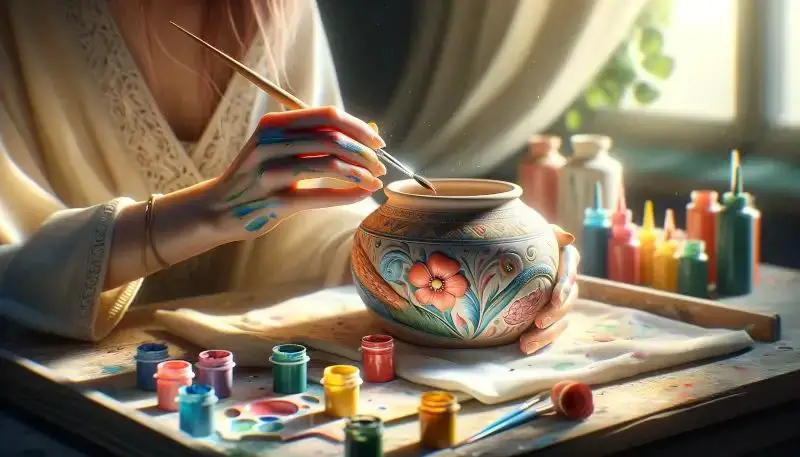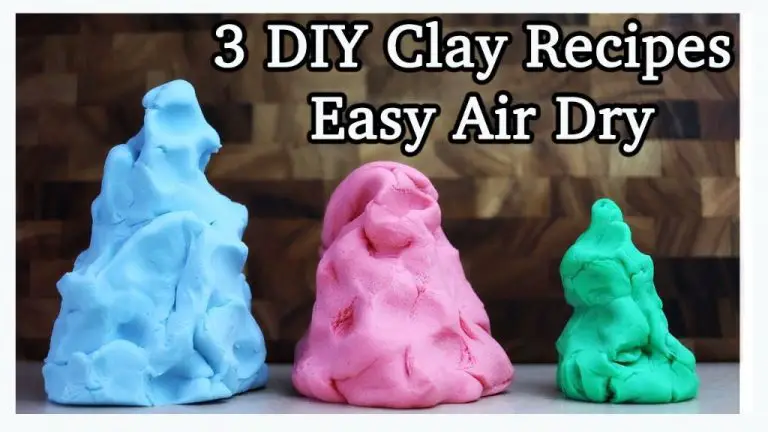Can You Paint Unglazed Pottery?
Unglazed pottery refers to clay pottery that does not have a glaze coating applied to the surface. The clay body is left in its natural bisque-fired state, revealing the texture and color of the clay. Unglazed pottery is porous and needs to be properly sealed if used with liquids. However, this natural porousness allows paints to soak into the clay body for a unique look.
There are many techniques for painting on unglazed pottery. Acrylic and oil-based paints work well and will adhere to the clay surface. Alcohol inks create vibrant, bleeding colors as the ink soaks into the body. Chalk paint, enamel paint, and metallic paints can also be used for decorative effects. Proper surface preparation is the key to achieving an even coat of paint that adheres. The pottery must also be sealed after painting. With simple preparation and sealing steps, unglazed pottery can be transformed through painting techniques for decorative or practical use.
Preparing Unglazed Pottery for Painting

Properly preparing the surface of unglazed pottery is an important first step before painting. This involves cleaning and lightly sanding the bisque to remove any dust or debris. According to the article “A Beginner’s Guide to Painting Ceramics”, you can use a damp sponge or cloth to wipe down the surface. Allow it to fully dry. Then, using 220 grit sandpaper, lightly sand the bisque to rough up the surface so the paint adheres better. Avoid sanding too aggressively as this can damage the clay body.
Another preparatory step is applying a primer or gesso to the raw clay. Priming gives the paint an extra layer of grip and prevents it from being absorbed directly into the porous clay. According to “Painting on Ceramics with Acrylics”, an acrylic primer formulated for ceramics works best. Apply a thin layer and let it dry before painting. Priming is an optional step but can lead to better results.
Acrylic Paint
Acrylic paint is one of the most commonly used paints on unglazed ceramics and terra cotta. Some key benefits of acrylics are that they dry quickly, are easy to clean up with water, and come in a wide range of vibrant colors suitable for ceramic painting projects (https://feelingnifty.com/acrylic-paint-on-ceramic/). However, acrylic paint does have some limitations on porous unglazed surfaces. The paint can soak into the material which leads to the colors becoming paler as they dry. Using an acrylic sealing primer first can help the true colors remain more vibrant. Acrylics also lack the glazing abilities of oils or enamel paints. Multiple thin layers must be built up for opacity.
When applying acrylic paint to unglazed ceramics, use soft brush strokes and avoid over-brushing as this can pull the paint out of the pores. Let layers dry in between applications. Acrylic paint can be diluted with water, but avoid using too much water when painting ceramics as it will make the paint soak in further. Using acrylic mediums can help increase adhesion. Once the paint is fully cured, apply a sealant like acrylic spray varnish to protect the finish.
Oil-Based Paint
Oil-based paints like artists’ oil paints can be used to paint designs on unglazed pottery and ceramics. Oil paints bond to the bare clay surface and become permanent after firing. The oil acts as the binder and carrier for the pigment in oil paint. The benefits of using oil paint on pottery include:
- Vibrant colors – oil paints have very rich, saturated hues.
- Blendability – oil paints blend smoothly for seamless color transitions.
- Permanence – oil paint is durable and becomes fully integrated into the clay after firing.
However, there are some limitations to be aware of when using oil paints:
- Long drying time – oil paints can take up to a week to fully cure and dry.
- Not food-safe – items painted with oils should not be used for food.
- Messy cleanup – brushes and surfaces need solvents for cleaning up after oil painting.
It’s important to take safety precautions when using oil paints. Oils emit strong fumes and require ventilation. Gloves and protection from skin contact are recommended, as some oil pigments can be toxic. When firing oil painted pottery, temperatures should be kept on the low side – under cone 04 – to avoid burning off the oils.
To apply oil paint to bare ceramic or clay, the surface should be clean, dry and lightly sanded for the paint to properly adhere. Multiple thin layers typically work better than thick single coats. Allow each layer to fully dry before adding the next. Blending, smoothing, texturing and other techniques can create beautiful ceramic decorations and designs.
Alcohol Inks
Alcohol inks are growing in popularity for painting on unglazed pottery. They offer some unique benefits as well as some drawbacks to consider.
One of the biggest benefits of alcohol inks is that they can create abstract, free-flowing designs not easily achieved with other paint types. The inks spread out and blend together in unpredictable ways as the alcohol evaporates. This makes them great for creative, abstract pottery painting (source).
However, the free-flowing nature of alcohol inks also makes them harder to control. It can be challenging to create precise designs. The inks also tend to soak into unglazed clay rather than sitting on top of the surface. This means some clay colors can impact the final results.
To use alcohol inks on pottery, it’s best to apply them in thin layers and let each layer dry fully before adding more. Tilt and rotate the pottery as you apply the inks so they flow across the surface. Use techniques like blowing through a straw or swirling with tools to manipulate the ink flows. Metallic alcohol inks can help add shimmer and dimension (source).
Overall, alcohol inks are a great choice for abstract pottery painting projects where you want to let the colors flow freely. Just be prepared for unpredictable results and a bit less control over the final designs.
Chalk Paint
Chalk paint is a popular type of paint to use on unglazed ceramics and pottery. It is water-based, matte, and comes in a variety of colors (cite https://www.squirrelsofafeather.com/diy-ceramic-chalk-paint-vase/).
Chalk paint is composed of chalk, which allows it to easily adhere to slick surfaces like ceramic and glass. It dries very quickly and provides excellent coverage. Chalk paint can give pottery a smooth matte finish or a distressed antique look.
One benefit of chalk paint is that it does not require sanding or priming prior to application on unglazed ceramics. It is also non-toxic and low odor. Distressing techniques like sanding or scraping can be used after painting to create an aged, antique appearance.
After painting with chalk paint, the surface should be sealed with a matte varnish or wax to protect the finish. An antiquing wax can be applied and then buffed off to add accentuated distressed details (cite https://www.pinterest.com/pin/424182858652876941/). The wax adds protection and a subtle sheen.
Enamel Paint
Enamel paint is a popular choice for painting unglazed pottery. Enamel paints provide a smooth, glass-like finish on ceramic bisque. According to The Creativity Exchange, “The Tetor’s enamel paints work beautifully on ceramic! Just remember they need to cure and then they’ll be good to go and the paint will last!”
Some key benefits of enamel paint include:
- Very durable and scratch-resistant finish
- Vibrant, opaque colors
- Smooth, glossy look
- Resists fading over time
Enamel paints do require proper curing in the oven or toaster oven after application. The curing process helps the paint adhere strongly to the bisque. Be sure to follow the manufacturer’s instructions for curing times and temperatures.
When applying enamel paint, work in thin layers using soft bristle brushes. Allow each layer to fully dry before adding another coat. Too thick of an application can cause cracking or chipping. Going slowly and allowing proper drying between layers will result in the best finish.
Proper ventilation is recommended when working with enamel paints, as the fumes can be strong. Wearing a respirator mask is advisable if working in an enclosed space. Work in a well-ventilated area whenever possible.
Metallic Paint
Metallic paints are popular for adding shimmering accents to pottery. Modern metallic paints are acrylic-based with powdered metal particles like copper, bronze, or aluminum mixed in to provide the metallic sheen.
Metallic paints create beautiful reflective surfaces and can totally transform the look of a ceramic piece. The metal particles make the colors shine in an iridescent way that seems to change based on the lighting and viewing angle.
There are a few techniques to achieve different metallic looks on pottery:
- Apply in a single solid coat for an all-over shimmer.
- Use a dry brush technique to highlight raised areas.
- Blend with other acrylic colors to tone down the metallic effect.
- Use a sea sponge for a mottled look.
- Paint stripes or patterns over a contrasting base coat.
Metallic paints work best on raw, unglazed clay. Make sure to apply a clear acrylic sealer after painting to protect the finish. The sealer helps prevent oxidation and dulling of the metallic particles over time. Multiple thin coats allow the metal flakes to reflect light better than a single thick coating.
Touch-ups and Sealing
Acrylic paint on unglazed pottery can chip or wear off with use. To fix any mistakes or touch up any chipped paint, simply use a small brush to repaint the area with acrylic paint. Let it dry fully before sealing.
Sealing painted unglazed pottery is highly recommended for protection and durability. There are several clear coat sealers that can be used:
- Polyurethane is a common sealer for acrylic paint. Apply 2-3 thin coats with a sponge brush and allow drying in between coats [1].
- Acrylic varnish can also be used to seal acrylic paint. Use an acrylic varnish formulated for ceramics and avoid oil-based varnishes [2].
- Clear glaze can be applied on top of dried acrylic paint. Use a ceramic glaze rated for the temperature of your kiln.
Once sealed, handwash painted pieces gently to keep the paint looking its best. Avoid abrasive scouring that could scratch the paint.
Creative Design Ideas
When painting designs on unglazed pottery, get creative with different patterns, textures, and themes. Abstract art and geometric shapes make for interesting designs. Here are some ideas:
Try painting various geometric patterns like diamonds, zigzags, dots, stripes, or chevron shapes. These classic motifs pair well together and look organized on a blank ceramic surface. For more texture, add details like faux embroidery stitches over patterns.
Make an abstract painting using acrylics or alcohol inks. Layer colors and make positive and negative spaces by adding and removing paint. Use sponges or crumpled plastic for texture. Dripping, splattering, and blotting paint also makes neat effects.
Choose fun themes for your pottery like animals, flowers, food, or seasonal. Paint cute kittens for cat lovers or an underwater scene with tropical fish. Florals like roses, sunflowers, or lavender sprigs make lovely designs. For kitchenware, try fruit shapes or savory dishes.
Personalize with names, inspirational words, or fun quotes. Use stencils for easy lettering. Enhance with shapes and colors that fit the recipient’s style. Date pieces to commemorate vacations, weddings, new homes, and other milestones.



